Balance Sheet: Definition, Components, and Example
A balance sheet is one of the most essential tools in your arsenal of financial reports. It’s used to state a business’s assets, liabilities, and shareholder’s equity at a given point in time, offering a snapshot of everything your business owns and owes and telling you the business’s overall worth. Generally speaking, balance sheets are instrumental in determining the overall financial position of the business.
What exactly is a balance sheet? What should be included in them? What equations go into making one? What are their limitations? And why is it so important to have one for your business? In this article, we’ll explain everything you need to know about a business’s balance sheet.
Key Takeaways
- Balance sheets are an important kind of financial statement used to look at a snapshot of a company’s finances on a given date, usually at the end of the month, quarter, or year.
- Assets are categorized based on their convertibility, physical existence, and whether they’re needed to operate the business.
- Accounting software is a great way to create accurate balance sheets quickly and easily.
Table of Contents
- What Is a Balance Sheet?
- Purpose of a Balance Sheet
- Balance Sheet Equation
- What Goes On a Balance Sheet?
- Balance Sheet Example
- Importance of a Balance Sheet
- Limitations of Balance Sheets
- Frequently Asked Questions
What Is a Balance Sheet?
A balance sheet is a type of financial statement that reports all of your company’s assets, liabilities, and shareholder’s equity at a given time. It’s a snapshot of the company’s financial health.
These financial statements are also key for calculating rates of return for your investors and for evaluating the capital structure of your business, both of which are essential processes.

Purpose of a Balance Sheet
Balance sheets have many important purposes, such as helping you understand your ability to pay for short-term operating expenses, supporting your repayment plan for debts, and ensuring proper distribution to equity-holding business owners.
Balance sheets can be used to analyze capital structure, which is a combination of your business’ debt and equity. Lenders will factor them into their decisions when doing risk management for credit. These reports are also used to disclose the financial position and integrity of your business (i.e., the overall value of your company), which is vital for attracting investors. Lastly, these statements are legally required to be produced and filed by public companies.
Balance Sheet Equation
Balance sheets work on a simple formula:
Assets – Liabilities = Shareholder Equity
What exactly does the above balance sheet formula mean? Let’s break it down into its 3 components:
- Assets: Current and long-term assets owned by the business, including cash, product inventory, property, or equipment
- Liabilities: This is any current, future, long, or short-term liability that the company owes, including rent, taxes, bills, and loans
- Shareholders Equity: This is the value of the company, indicated by shareholders’ funds, retained earnings, and/or the worth of common stock
Let’s go over each of these 3 elements in more detail in the next section.
What Goes on a Balance Sheet?
The balance sheet details the total assets, liabilities, and owner’s equity of your business at a given point in time. The items reported on these financial statements correspond to the accounts outlined on your chart of accounts. A balance sheet is made up of the following elements:
Assets
The assets section of your report breaks down what your business owns. Your report will list your total assets in order of liquidity; that is, it reports assets in order of how easily they can be converted to cash. Assets are categorized as follows:
Convertibility
This outlines how easily an asset can be converted into cash. Convertibility is broken down into types of assets:
- Current Assets: Current assets can be easily converted into cash (or an equivalent) in 1 year or less. Examples of current assets include cash on hand or in bank accounts, short-term deposits, loan receivable, stock, and marketable securities.
- Fixed Assets: Fixed assets can’t usually be converted into cash or cash equivalents quickly. Examples of fixed assets include buildings, trademarks, machinery, and equipment.
Physical Existence
Your total assets are further broken down as either tangible or intangible, depending on whether they physically exist or not:
- Tangible: Tangible assets are things you can physically see and feel, such as equipment, supplies, machinery, or property.
- Intangible: Intangible assets are valuable but don’t physically exist in the real world. These include copyrights, brands, trademarks, and patents.
Usage
We break assets down even further on a balance sheet by whether they’re considered operating or non-operating assets:
- Operating: These assets are necessary for usual business operations, including property, machinery, or equipment.
- Non-Operating: Non-operating assets aren’t essential for operating the business. They include short-term investments or securities that don’t impact day-to-day business.
Liabilities
The next section on the balance sheet lists the company’s liabilities. Your liabilities are the financial responsibilities that you owe to others, including the outstanding payments to your vendors, loan repayments, and other forms of debt. Liabilities are further broken down into current and long-term liabilities:
- Current Liabilities: These are debts or other financial obligations that must be paid for within 1 year. This could include rent, utilities, taxes, current payments toward long-term debts, interest payments, and payroll payables.
- Long-Term Liabilities: Long-term liabilities are debts or obligations that will need to be paid in more than 1 year from now. These include long-term loans, deferred income taxes, and pension fund liabilities.
Owner’s Equity/Earnings
Owner’s equity (also called shareholders’ equity or stakeholders’ equity, for corporations) refers to:
- The amount of money generated by a business after deducting all the money owed
- The amount of money put into the business by its owners or shareholders
- And any donated capital
In other words, shareholder’s equity is your net assets. Put another way, it’s the amount of money that can go to your shareholders after your debts are paid and your total assets are converted into cash/cash equivalents. On your balance report, it’s calculated using this formula:
Owner’s Equity = Total Assets – Total Liabilities
Balance Sheet Example
Here’s an example to help you understand the information to include on your balance sheet. In the example below, we see that the balance sheet shows assets (such as cash and accounts receivable), liabilities (such as accounts payable, credit cards, and taxes payable), and equity. Total liabilities and equity are also added up at the bottom of the sheet—hence the term ‘bottom line’ for this number.
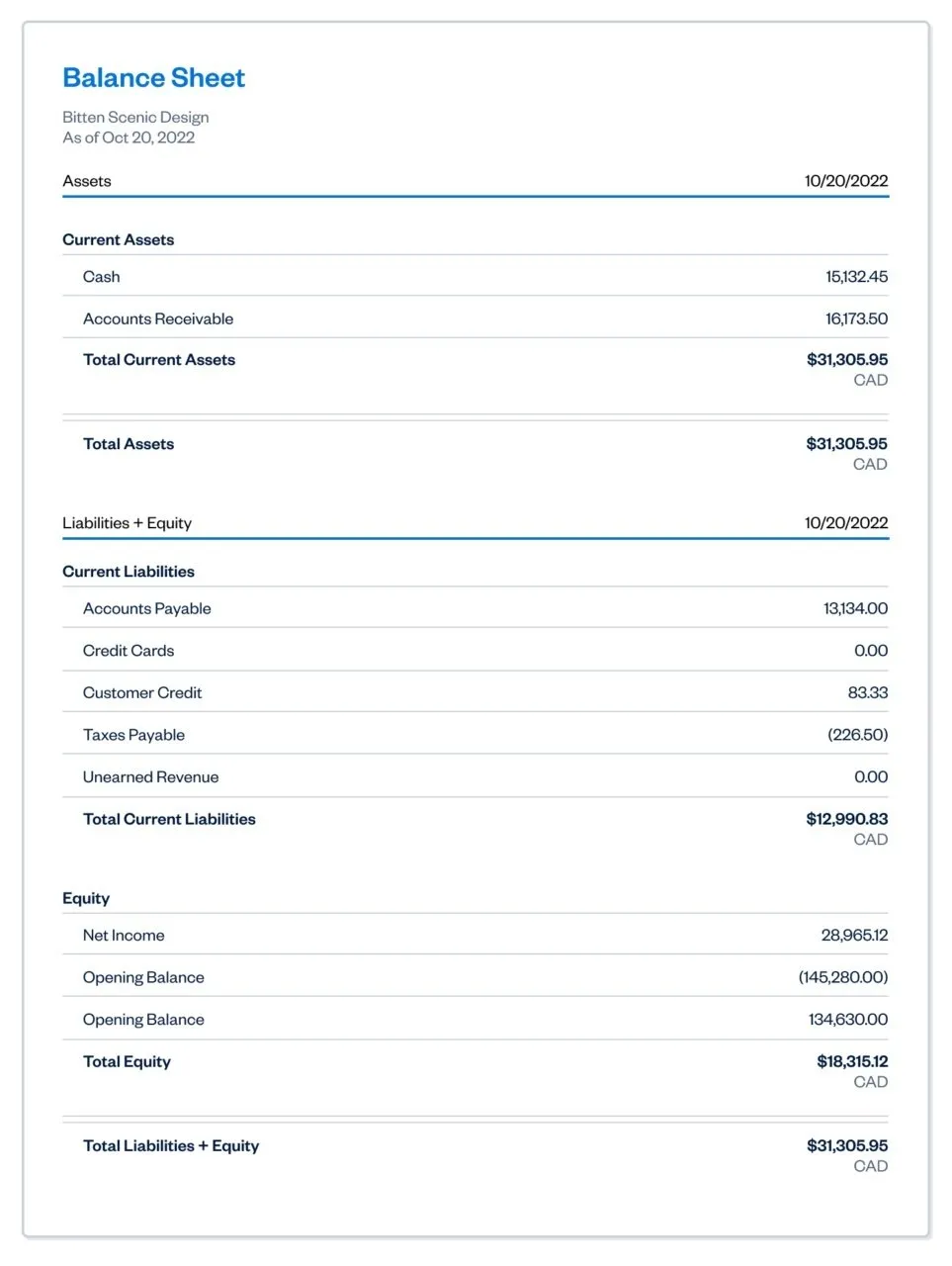
Looking for an even simpler way to create balance sheets that support your business? FreshBooks’ free balance sheet template will help you keep track of all the information you need to manage your numbers with ease, helping you to check balances and keep your finances in order.
Importance of a Balance Sheet
Balance sheets are important for determining the financial health and position of your business at a certain point in time. When used with other financial statements and reports (such as your cash flow statement), it can be used to better understand the relationships between your accounts.
Other important insights from your balance sheet include:
Liquidity
By comparing your business’s current assets to its current liabilities, you’ll get a clearer picture of the liquidity of your company. In other words, it shows you how much cash you have readily available. Your total assets should be greater than your liabilities. It’s wise to have a buffer between your current assets and liabilities to at least cover your short-term financial obligations. The data from financial statements such as a balance sheet is essential for calculating your business’ liquidities.
Efficiency
By comparing your income statement to your balance sheet, you can measure how efficiently your business uses its total assets. For example, you can get an idea of how well your company can use its assets to generate revenue.
Leverage
Your balance sheet can help you understand how much leverage your business has, which tells you how much financial risk you face. To judge leverage, you can compare the debts to the equity listed on your balance sheet. Leverage can also be seen as other people’s money you use to create more assets in your business.
Limitations of Balance Sheets
Balance sheets are important for investors, analysts, accountants, and anyone else gauging the success of a business. However, they also have some limitations to keep in mind. These limitations are Limited Snapshot, Static Data & Potential for Manupulation include:
Limited Snapshot
These financial statements can only show the financial metrics of your company at a single moment in time. While this is very useful for analyzing current and past financial data, it’s not necessarily useful for predicting future company performance.
Static Data
Balance sheets are an inherently static type of financial statement, especially compared to other reports like the cash flow statement or income statement. Analyzing all the reports together will allow you to better understand the financial health of your company.
Potential for Manipulation
Accounting systems or depreciation methods may allow managers to adjust numbers on the balance sheet. This opens up balance sheets to corruption. Some executives may fiddle with balance sheets to make businesses look more profitable than they actually are. Thus, anyone reading a balance sheet should examine the footnotes in detail to make sure there aren’t any red flags.

Conclusion
With a firm understanding of the balance sheet basics, you can use this report to guide financial decision-making in your business. Although it takes time and effort to create an accurate balance sheet from scratch, it is a vital report you as a business owner should have. FreshBooks is here to help and automate the report.
Our accounting software is a fast, easy, reliable way to create a balance sheet. By keeping your business’s financial information up-to-date by switching your accounting process from doing it manually to FreshBooks, creating a balance sheet takes just a few clicks. Try FreshBooks for free!
FAQs About Balance Sheets
Still curious about creating, using, or interpreting balance sheets? Here are a few commonly asked questions—answered:
How do you analyze a balance sheet?
The best technique to analyze a balance sheet to determine the financial health of a business is through financial ratio analysis. There are 2 types of ratios: Financial strength ratios, which, for example, can tell you how well a company can meet its debt obligations, and activity ratios, which focus on current accounts and operating cycle expenses.
Who prepares balance sheets?
Balance sheets are usually prepared by company owners or company bookkeepers. Internal or external accountants can also prepare and review balance sheets. If a company is public, public accountants must look over balance sheets and perform external audits.
What are the 3 types of balance sheets?
The 3 types of balance sheets are: comparative (compares more than one period simultaneously to help identify trends), vertical (a single column that shows a company’s assets, liabilities, and equity for a given date), and horizontal (a different way of presenting the same information as compared to the vertical balance sheet).
What is a balance sheet versus an income statement?
A balance sheet shows only what a company owns (and owes) on a specific date by displaying assets, liabilities, and equities. An income statement, on the other hand, reports revenues and expenses over a longer period. Balance sheets are used to determine if a company can meet its debt obligations, while income statements gauge profitability.
How do you read a balance sheet for dummies?
The easiest way to read a balance sheet is to keep the formula in mind: Assets = Liabilities + Shareholder Equity. You can look at your company’s balance sheet as having 2 sections—1 for assets, and 1 for liabilities and equity. By adding liabilities and equity together, you’ll get your company’s assets. You can also use the Assets – Liabilities = Equity formula. It’s important for Liabilities to always be lower than the Assets. Otherwise, it would mean that the business is losing money.
Reviewed by
Sandra Habiger is a Chartered Professional Accountant with a Bachelor’s Degree in Business Administration from the University of Washington. Sandra’s areas of focus include advising real estate agents, brokers, and investors. She supports small businesses in growing to their first six figures and beyond. Alongside her accounting practice, Sandra is a Money and Life Coach for women in business.
RELATED ARTICLES


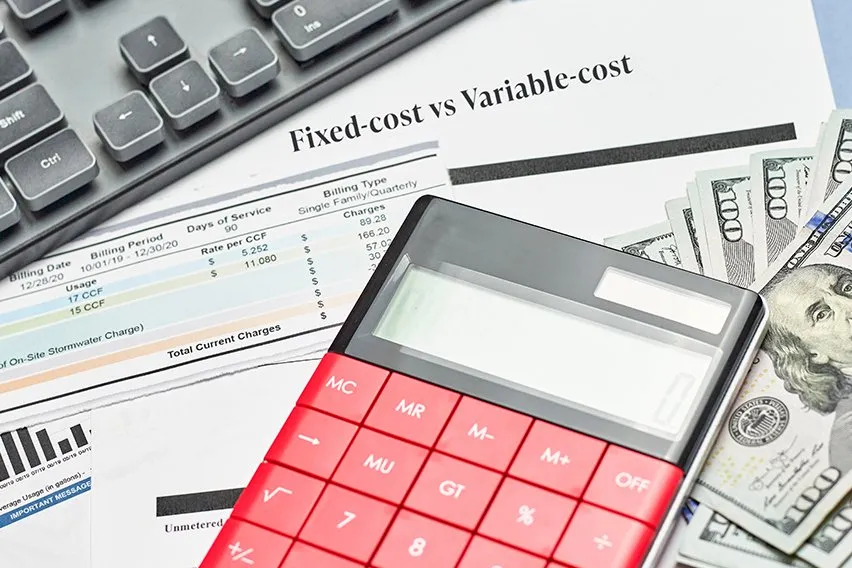 Fixed vs. Variable Costs: What’s the Difference
Fixed vs. Variable Costs: What’s the Difference Gross Profit Margin: Formula, Calculation and Example
Gross Profit Margin: Formula, Calculation and Example Bank Reconciliation: Definition, Example, and Process
Bank Reconciliation: Definition, Example, and Process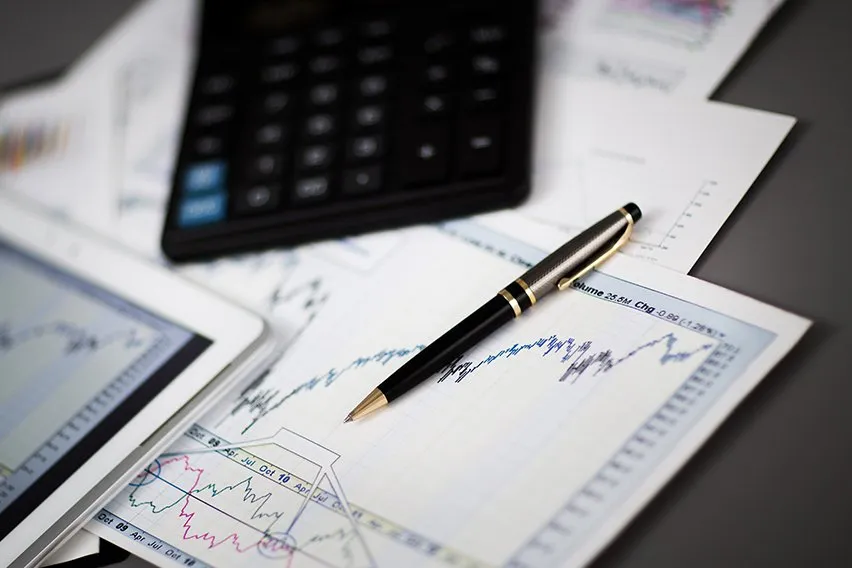 What is Solvency vs Liquidity?
What is Solvency vs Liquidity?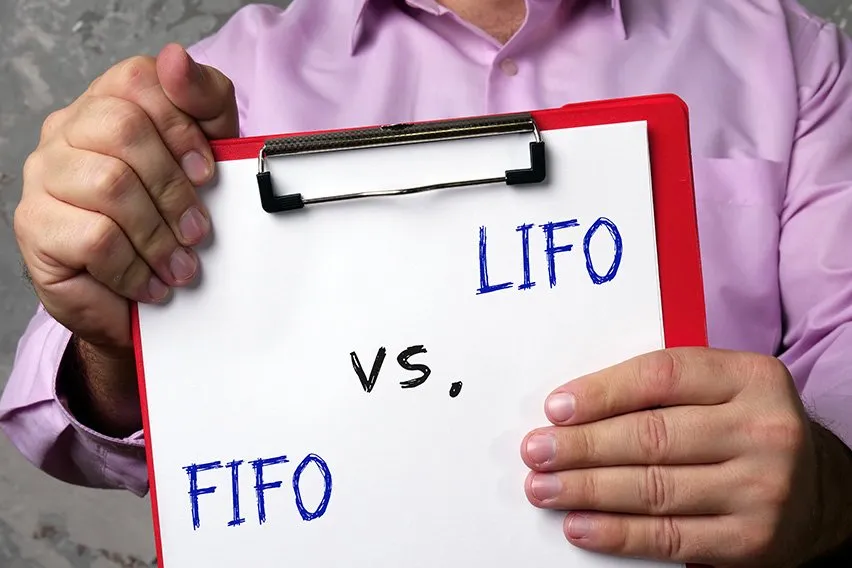 How to Calculate FIFO and LIFO
How to Calculate FIFO and LIFO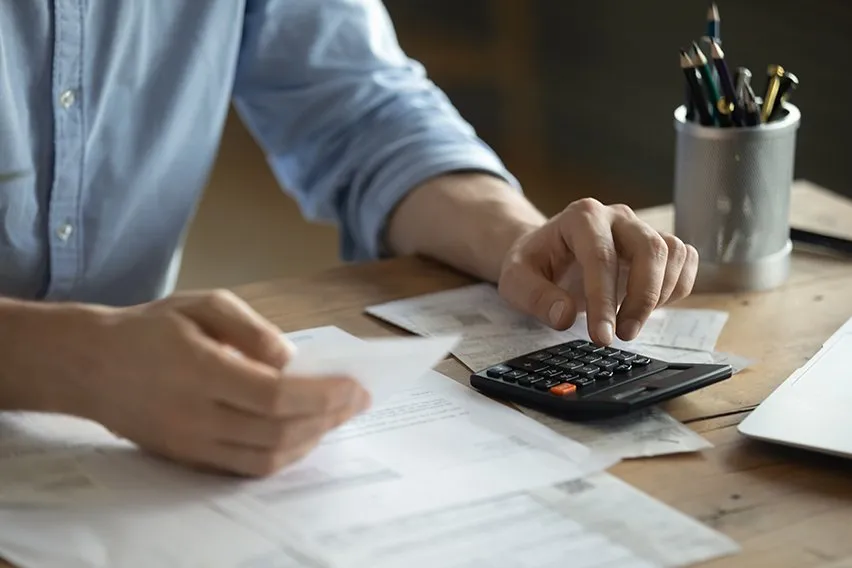 How To Prepare An Income Statement
How To Prepare An Income Statement